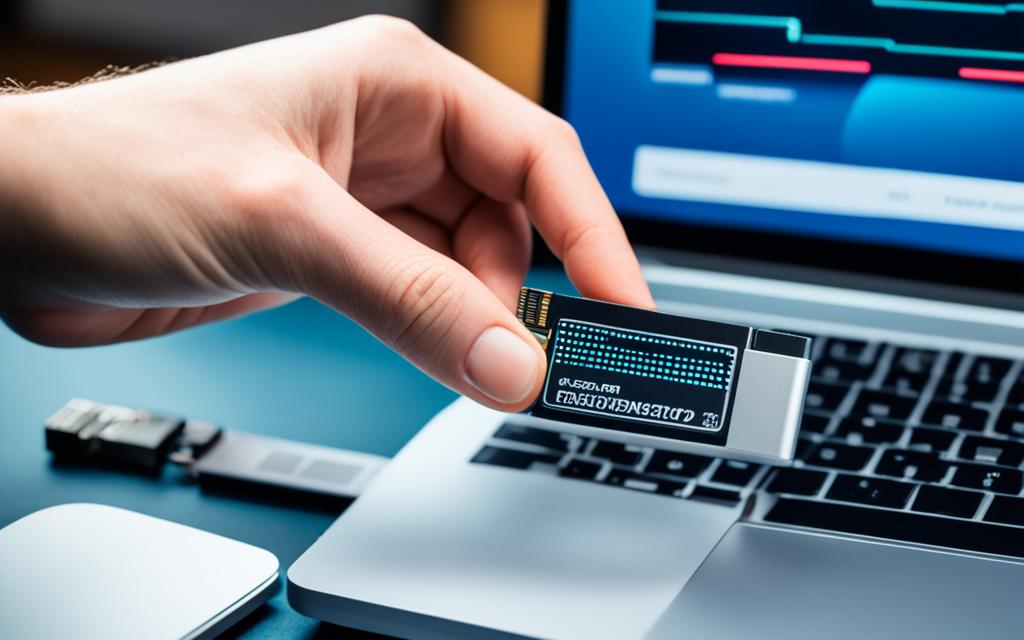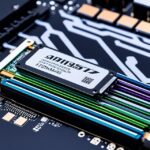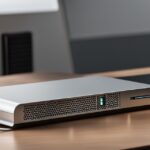Table of Contents
NVMe SSDs are known for their incredible speed and performance. These drives, first designed for use inside laptops and desktops, can now be used externally. This brings us the advent of fast, portable NVMe drives. This piece will delve into the world of NVMe SSD technology. We’ll look at their benefits and how they can be turned into external storage. By exploring compatibility, installation, and performance, you’ll understand how to boost your data handling. For those looking to upgrade their storage solutions, SSDs offer a blend of speed and flexibility. For more details on making SSDs external, visit M.2 SSDs as external storage1.
Key Takeaways
- NVMe SSDs offer incredibly fast data transfer rates compared to traditional hard drives.
- External NVMe drives are highly portable, making file backups and transfers seamless.
- Compatibility requirements must be considered when setting up external NVMe SSDs.
- Proper enclosures are critical for optimising performance and cooling.
- Repurposing older SSDs as external drives can provide additional storage solutions without substantial investment.
Understanding NVMe SSD Technology
NVMe technology marks a major step forward in storing data. It makes the most of modern interfaces like PCIe for speed and efficiency. Since its launch in 2013, NVMe has changed the way we handle and access data. It offers major benefits over older storage methods.
What is NVMe?
NVMe stands for Non-Volatile Memory Express. It’s a protocol that lets solid-state drives talk to the computer’s motherboard via PCIe interface. Thanks to this, NVMe SSDs can move up to 25 times more data than SATA ones. They use PCIe slots more efficiently2. NVMe’s command structure is better too, allowing commands to be processed twice as fast as older AHCI drivers. This boosts system performance significantly.
Advantages of NVMe Over Traditional SSDs
NVMe SSDs have a huge advantage because they’re much faster. SATA SSDs have latencies around 6 microseconds, but NVMe drives can go as low as 2.8 microseconds2. This makes NVMe SSDs able to do over 1 million IOPS. That’s up to 900% faster than traditional drives2.
NVMe can handle lots of tasks at once because it supports many command queues—64K versus just one with AHCI. This makes multitasking much smoother.
Performance Metrics and Speed Test Results
NVMe’s performance metrics are impressive. While SATA SSDs top out at 600 MB/s, NVMe drives can hit speeds between 3,000 MB/s and 7,500 MB/s3. The best NVMe drives, like those made by Kingston, get up to 7,300 MB/s read speeds and 7,000 MB/s write speeds. That’s great news for gamers and power users2. Thanks to PCIe 4.0, NVMe now offers double the data speed of PCIe 3.0, with speeds up to 32,000 MB/s2.
| Feature | NVMe SSD | SATA SSD |
|---|---|---|
| Year Introduced | 2013 | 2006 |
| Data Transfer Speed | Up to 7,500 MB/s | Up to 600 MB/s |
| Latency | As low as 2.8 microseconds | Up to 6 microseconds |
| IOPS | Over 1 million | Up to 100K |
| Command Queues | 64K | 1 |
In summary, NVMe technology is a strong choice in the storage world. It brings unmatched speed and efficiency, essential for demanding modern applications23.
Benefits of Using an NVMe SSD Externally
External NVMe SSDs offer great advantages, improving how we use our devices. They stand out with their superior data transfer speed. This makes them perfect for everything from gaming to big projects.
Enhanced Data Transfer Speeds
External NVMe SSDs boast amazing data transfer speed. They can hit read and write speeds up to 3,000MB/s. That’s way faster than SATA SSDs, which top out around 500MB/s. This means they’re six times quicker4.
When paired with USB 3.2 Gen 2 Type-C, speeds can soar up to 10Gbps. Users get to unlock the full potential of these drives. This boost greatly improves productivity and overall performance.
Portability and Flexibility in Data Backup
External NVMe SSDs are small and easy to take anywhere. They can hold up to 2TB. This makes moving large amounts of data simple. They work with different devices which is great for backups and transferring big files5.
Cost-Effective Storage Solutions
Choosing an NVMe SSD and adding your own enclosure is a smart, budget-friendly move. It lets you create a custom setup that fits exactly what you need. This way, users get the best performance without overspending. They combine top performance with savings, all thanks to NVMe technology.
| Feature | SATA SSD | NVMe SSD |
|---|---|---|
| Typical Read Speed | 500MB/s | 3,000MB/s |
| Power Consumption | Higher | Lower |
| Durability | Moderate | Higher |
| Use Cases | Basic Tasks | Gaming, Video Editing, 3D Rendering |
External NVMe SSDs are essential for gamers, editors, or anyone looking to upgrade their storage. They make a big difference in how we store and access data. A smart choice for improving our tech setup5.
Can I Use NVMe SSD Externally?
Using an NVMe SSD externally gives you lots of options for keeping and moving data. First, you must understand what’s needed and check if everything fits together well. This makes sure you get the best speed and experience using it.
What You Need for External Usage
To use NVMe external compatibility, you’ll need an M.2 NVMe enclosure that supports newer connections like USB-C or Thunderbolt. These casings protect the drive and keep its high-speed performance. Enclosures now can hold larger drives, up to 2TB.
One popular choice is the Icy Box SSD enclosure. It comes with both USB-C and USB 3.0 cables. This makes it very user-friendly5.
Compatibility Considerations
When picking an enclosure, it must fit your SSD’s needs. This means checking both the NVMe drive’s type and size. Gen4 SSDs, for example, are faster than Gen3, reaching speeds up to 7,000MB/s.
It’s also key to look at the connection speed to avoid slow-downs. USB-C generally works faster than USB-A. Drives like the Crucial X9 and X10 Pro work well across their full space, giving a smooth user experience6.
How to Set Up an NVMe SSD for External Use
Setting up an NVMe SSD for external use is simple. It unlocks the full capacity of your data storage. Following the right steps boosts efficiency and performance. It makes your experience with high-speed data transfer and dependable storage better. This guide details installing, configuring, and preparing an external format SSD for great performance.
Choosing the Right Enclosure
Selecting the right enclosure is key for setting up your NVMe SSD. It must fit M.2 drives and help prevent overheating with good heat dissipation. Enclosures that support fast connections, like USB 3.1 Gen 2 and Thunderbolt 3, are ideal. They improve performance with speeds over 900MB/s7. Check if it works with different operating systems for easy integration.
Installation and Configuration Steps
Installing the NVMe drive into the enclosure requires care. Insert the drive at a 30° angle for the best connection8. Once in place, connect the enclosure to your computer. Check if your operating system supports it. Some enclosures may need basic tools for installation, making the process easier.
Reformatting the SSD for External Use
To use the NVMe SSD externally, it needs reformatting. Windows Disk Management utility can reformat the drive using NTFS or exFAT8. This step makes sure the drive works well with the operating system. It improves performance and data handling. Tools like Seagate’s DiscWizard also offer easy data transfer from old drives8.
Performance Considerations When Using NVMe Externally
Using NVMe SSDs externally boosts performance, but there are limits to be aware of. Knowing how they connect and their external uses can improve your experience.
Potential Bottlenecks in Data Transmission
NVMe SSDs are fast, with speeds up to 7,000MB/s. But a USB 3.0 link may reduce this to 5GB/s, impacting performance9. The tech industry is making things better, making devices quicker and more responsive than old storage10. However, even with the newest PCIe 5.0 SSDs, some fast Ethernet connections can’t keep up11.
Proper Use Cases for External NVMe Drives
External NVMe drives are great for moving big files quickly. They’re perfect for gaming and heavy apps, with speeds reaching up to 3500 MB/s for reading10. They can also be bootable, great for gaming setups or as portable storage11. Their high IOPS rates make them top picks for tough tasks10.
Conclusion
Using NVMe SSDs externally brings many benefits. These include better performance and easier carrying. They are great for handling data. NVMe drives can transfer data at speeds up to 7,300MB/s. This is much faster than older SATA drives, which top out at 6GB/s69. Their speed makes backing up files quick and moving media easy.
NVMe technology gives us more flexibility in managing our data. As our lives rely more on data, fast external storage helps us keep up. With the right setup, external NVMe SSDs can help in many ways. They are good for gaming and managing big work tasks6.
To sum up, our need for better tech brings us towards external SSDs. They mix speed, efficiency, and ease of use. External NVMe SSDs help both personal and professional tasks. For more information on these drives, check out this detailed guide6.
FAQ
Can I use an NVMe SSD as an external drive?
Yes, you can use NVMe SSDs as external drives. You need an M.2 NVMe enclosure with USB-C or Thunderbolt connections.
What are the benefits of using an external NVMe SSD?
External NVMe SSDs give you quick data transfer speeds. They are portable, so you can easily carry large files around. They’re also more affordable than pre-made external drives.
What do I need to set up an NVMe SSD for external use?
For external use, you’ll need an M.2 NVMe enclosure that fits your drive. Also, you should use a USB 3.2 or Thunderbolt connection for the best speed.
How does NVMe technology differ from traditional SSDs?
NVMe technology uses the PCIe interface. It cuts down delay and boosts the number of operations per second. This is much more efficient than old SATA SSDs.
How fast can an NVMe SSD transfer data?
NVMe SSDs can reach speeds up to 7000MB/s under the right conditions. That’s way faster than SATA SSDs, which usually max out around 600MB/s.
Can I experience bottlenecks when using an external NVMe SSD?
Yes, if you use slower connections like USB 3.1 or bad enclosures, your NVMe’s speed can drop. This can cause bottlenecks in moving data.
What types of drives should I use for gaming and video editing?
For gaming and video editing, NVMe SSDs are the best. They have fast data access and low latency. This makes them perfect for heavy-duty tasks.
How do I reformat an NVMe SSD for external use?
To reformat, connect the SSD to your computer. Then, use your operating system’s disk management tools. You’ll usually format it to NTFS or exFAT for compatibility.
Source Links
- https://www.kingston.com/en/blog/personal-storage/use-your-old-ssd-as-external-storage – How to Use Your Old SSD as an External Storage Drive
- https://www.kingston.com/en/ssd/what-is-nvme-ssd-technology – What is NVMe SSD technology? – Kingston Technology
- https://www.backblaze.com/blog/nvme-vs-m-2-drives/ – NVMe vs. M.2 Drives: Which SSD Is Right for You?
- https://www.crucial.com/articles/about-ssd/why-upgrade-to-nvme-ssd – Why you should upgrade to an NVMe SSD
- https://www.physicsforums.com/threads/regarding-ssd-ssd-enclosures.1052124/ – Can SSD Enclosures Handle Gaming Without Lag?
- https://www.crucial.com/articles/external-ssd/external-ssds-vs-internal-ssds – Internal vs External SSD: Which Type is Faster?
- https://plugable.com/products/usbc-nvme – Plugable USB 3.1 Gen 2 Tool-free NVMe Enclosure
- https://www.seagate.com/blog/how-to-install-an-nvme-ssd/ – How to Install & Format your M.2 NVMe SSD | Seagate US
- https://www.kingston.com/en/blog/pc-performance/top-reasons-upgrade-nvme-ssd – Top 6 Reasons to Upgrade to an NVMe SSD
- https://www.startech.com/en-us/blog/m2-nvme-storage-explained – Improve the Performance of Hybrid and Remote Workers Using M.2 NVMe SSDs
- https://www.enterprisestorageforum.com/news/nvme-performance-will-force-applications-to-process-data-where-its-stored/ – NVMe Performance Will Force Applications to Process Data Where It’s Stored








